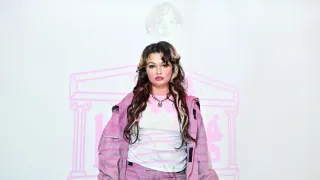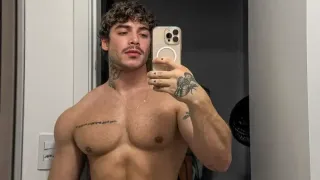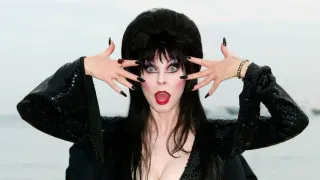August 2, 2015
Once in Love with Amy
Kilian Melloy READ TIME: 5 MIN.
Amy Winehouse, the soulful British singer/songwriter whom Tony Bennett once called the best jazz vocalist of her generation, had it all: A big, heart-rending voice, fame and success, none of which saved her from the inner demons that overtook her, or the downward spiral into drug and alcohol addiction that led to her death four years ago. Most of what is known about Winehouse comes from tabloids and magazines, her music, and most recently, Asif Kapadia's heartbreaking documentary Amy. But who was this fragile, prodigiously talented young woman, mercilessly hounded by the paparazzi, whose autobiographical songs such as "Rehab," "You Know I'm No Good" and "Back to Black" still haunt listeners, and whose life came to a tragic and very public end at the age of 27?
Through her favorite books (Nabokov, Dostoyevsky and Bukowski were on her reading list), her record collection, vintage memorabilia and numerous family photographs, Amy Winehouse: A Family Portrait, a new exhibition at the Contemporary Jewish Museum, offers an intimate, unusually personal perspective of Winehouse's brief life, seen through the loving eyes of her older brother; his poignant recollections, which serve as narration, appear throughout the gallery. A bittersweet homage by a brother wanting to reclaim the sister he knew, this modest show, organized by the Jewish Museum London in close collaboration with the family, presents the private Amy, whose big career and terrible troubles remain largely offstage. It highlights formative influences such as her beloved grandmother, Cynthia, who as a glamorous young bohemian in the 1950s dated jazz musician Ronnie Scott. She conveyed a passionate love of music to her young granddaughter, as well as a flair for fashion, though Amy's signature beehive hairstyle and heavy eyeliner were borrowed from early 1960s American girl groups like the Ronettes. "I just dress like it's still the 50s," reads a quote in a section devoted to fashion that includes bare cocktail dresses that accentuated her tiny frame; a sexy polka-dot halter number; a racer-back tank-top worn with leopard print cut-offs; and a pink satin, custom bowling jacket. A special glass case houses the strapless, Luella Bartley Midnight-blue, lotus-petal sequin mini-dress, paired with sky-high Christian Louboutin patent leather heels, which she wore for a performance at Glastonbury in 2008. Wow! In another photo, a beaming Amy, clearly reveling in the perks of stardom, poses beside a stack of shoeboxes.
Amy, the descendent of Eastern European Jews who immigrated to England in the late 1800s, grew up in the North London suburb of Southgate in a home filled with music. Her father, Mitch, a cabbie with thwarted musical ambitions who exploited his daughter's success, listened to Frank Sinatra, and Alex introduced her to jazz pianist/composer Thelonious Monk. She soon developed sophisticated tastes for gospel, soul and jazz greats like Sarah Vaughan, Ray Charles, Ella Fitzgerald, Billie Holiday, Dinah Washington, and her musical hero, Tony Bennett.
A short video in the exhibition of a rambunctious teenage Amy, already a charismatic stage presence, fronting a concert at theater school, where she briefly matriculated, and the images of a healthy, full-faced rebellious girl smiling back in photographs are quite a contrast to the troubled young woman whose unraveling played out in the relentless glare of flashbulbs. But if you're looking for clues in her family history as to what led to her addiction, her disastrous taste in men, or the bulimia that reduced her petite physique to skeletal proportions, you won't find it here. Her parents' divorce, for instance, isn't even mentioned. Neither will you hear her songs inside the gallery, though a video of her performance of "Back to Black," delivered at a small concert in Dingle, Ireland, in 2006, when she was at the height of her powers, plays at the entry to the show. The justification for leaving her music out of the equation, made by the London-based curator and her brother, is they wanted to create a space Amy would have been comfortable living in. But the choice robs the experience of a potent energy resource. The raw emotional power of her voice, which can move listeners to the edge of their seats, is why most of us care and mourn her loss, and it's the raison d'etre for an exhibition.
Although overly long, Kapadia's documentary provides a broader, more nuanced portrait and trajectory of an ambitious, vulnerable young woman who lived fast and died young, through clips and grainy home movies from childhood on, observations from Amy's former manager, and early, live-performance footage that's electrifying. The film also makes viewers inadvertently complicit in the humiliating spectacle of her meltdown, as she's exploited by hangers-on, like the drug-addicted parasite of a husband whom she loved beyond reason, or when she falls down drunk during a concert gig, with the paparazzi, like a pack of hyenas, never far behind, driving her half-mad. Trying to escape the horde, she takes an island vacation, only to have her father show up with a film crew in tow. In the movie's most touching scene, where she's in the studio recording a duet with Bennett, she's flustered and as jittery as a high-strung thoroughbred. Recognizing her anguish, the seasoned, generous old pro gently coaxes and reassures her, bringing her back to her art. Maybe, with age and maturity, she could have found her way there, but time ran out.
'No Good'
In You Know I'm No Good, a small companion show also at CJM, three contemporary artists train their sights on the flip side of celebrity, deconstructing the Amy Winehouse phenomenon with wit and wisdom. New York-based Rachel Harrison's colored pencil drawings portray Amy with outsized purple or blue hair in the company of artists ranging from Picasso and Willem de Kooning to Gertrude Stein. Local artist Jason Jagel, who has designed cover art for rap and R&B musicians, has contributed three works including "Crepuscule with Another Amy" (2015), a cartoonish fictional history referencing figures in black American music that shaped the foundation for Amy's persona and singing style, like Thelonious Monk and Harlem stride pianist Willie "The Lion" Smith, who appears in the guise of a grinning, cigarette-smoking, derby-wearing canine piano player. It's always worth going out of one's way to keep up with the wickedly imaginative, dark-side-of-the-mirror work of the wonderful San Francisco artist Jennie Ottinger. In her installation "Mouth to Mouth" (2015), she takes on the wholesale appropriation of black music by whites and the African-American chanteuses whose legacy Winehouse built upon, through doll-like cut-outs of girl groups like the Supremes and the Ronettes, along with dismembered body parts - feet, calves and mouths open in song - that are pasted on the wall.
"You Know I'm No Good" and "Amy Winehouse: A Family Portrait" run concurrently through Nov. 1 at CJM-SF.






